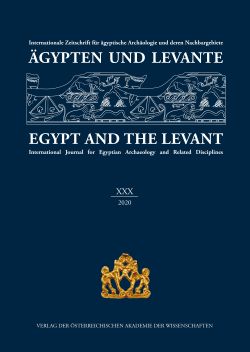Silvia Prell
S. 495 - 533
doi:
10.1553/AEundL30s495

Verlag der Österreichischen Akademie der Wissenschaften
doi:
10.1553/AEundL30s495
Abstract:
So-called ‘toggle pins’ are a common find, not only in the Middle, but already in the Early Bronze Age. When found in tombs, they can accompany males and females and the common opinion is that they held together a burial shroud, or specifically the garment of the deceased. The first metal toggle pins appear in the Chalcolithic Period, mainly in south-eastern Anatolia. They became common in Syro-Mesopotamia from the middle of the Early Bronze Age onwards. Most of the earliest examples are unperforated, but a few perforated specimens are attested already from the end of the 4th millennium BCE. Clothing pins were introduced into the southern Levant at the end of the Early Bronze Age, but perforated pins are few in number, getting common only at the beginning of the Middle Bronze Age and are then widely diffused in the region until the end of the period. Plain pins and pins with cylindrical heads and ribbed decoration are the most common types at Tell el-Dabʿa and the rest of the Eastern Delta, where pins do not show as much variety as those from the southern Levant. In all, forms are quite comparable and spread across a wide area, which is not astonishing as the shape is designed for a specific practical use. Nonetheless, distinct forms, decorations or materials might point to a common cultural background of the owners, especially as clothing pins are an entirely non-Egyptian type of object.
clothing pins, Tell el-Dab’a, Eastern Delta, Levant, foreign relations
Published Online:
2020/12/29 08:28:07
Object Identifier:
0xc1aa5576 0x003c1f87
Rights:All rights reserved.For questions regarding copyright and copies please contact us by email.
Die Zeitschrift Ägypten und Levante wurde im Jahr 1990 von Manfred Bietak begründet, um den Forschungen zu den Kulturkontakten zwischen Ägypten und seinen Nachbarländern sowie der ägyptisch-kanaanäischen Hybridkultur, wie sie vor allem bei den österreichischen Ausgrabungen in Tell el-Dab’a zutage trat, eine Publikationsplattform zu bieten. Von Anfang an war die Zeitschrift international und interdisziplinär ausgerichtet. Das Themenfeld geht über die ursprüngliche Kernthematik weit hinaus und umfasst sowohl Vorberichte und Berichte zu archäologischen Grabungen in Ägypten und dem gesamten Vorderen Orient sowie Nubien und dem Sudan, wie auch Artikel zu allen Aspekten der ägyptischen und nahöstlichen Archäologie, Geschichts- und Kulturwissenschaft. Der Fokus liegt auf der pharaonischen Zeit, jedoch sind sowohl Beiträge zur Ur- und Frühgeschichte der genannten Regionen wie auch zur nachpharaonischen Antike möglich. Dazu wird ein weites Feld an naturwissenschaftlichen Themen abgedeckt, von Fragen der C14-Datierung über materialkundliche Untersuchungen bis hin zu archäobotanischen, archäozoologischen und anthropologischen Arbeiten.
Ägypten und Levante erscheint einmal jährlich im Druck und online. Die Redaktion ist bemüht, eingereichte Artikel möglichst zeitnah zu publizieren. Beiträge sind in Deutsch, Englisch oder Französisch einzureichen. Buchbesprechungen und Rezensionen werden nicht publiziert. Alle eingereichten Artikel werden einem internationalen peer-review Verfahren gemäß den Qualitätsstandards der Österreichischen Akademie der Wissenschaften unterzogen.
Egypt and the Levant was founded by Manfred Bietak in 1990 to provide a publication platform for the research on cultural contacts between Egypt and her neighbours. A focus of interest was the Egyptian-Canaanite fusion of cultures, which was mainly encountered at the site of Tell el-Dab’a during the Austrian excavations. From the beginning, the scope of the journal was international and interdisciplinary. The subject area has now been greatly expanded far beyond the original topics. It comprises reports and preliminary reports on archaeological excavations in Egypt and the entire Middle East including the Sudan, as well as articles dealing with all aspects of Egyptian and Near Eastern archaeology, history or cultural history. The main emphasis lays on the pharaonic period, but both contributions to prehistory of the said regions, and post-pharaonic periods may be accepted. In addition, a broad range of scientific topics is covered, including C14-dating, material analyses, archaeobotanical and archaeozoological studies as well as studies in physical anthropology.
Egypt and the Levant is published on an annual basis, both in print and online. Submitted articles are intended to be published in a timely manner. Manuscripts may be submitted in English, German or French. Book reviews are not accepted. All submitted articles are subject to international peer-review according to quality standards of the Austrian Academy of Sciences.



 Home
Home
 Print
Print
 References
References
 Share
Share

